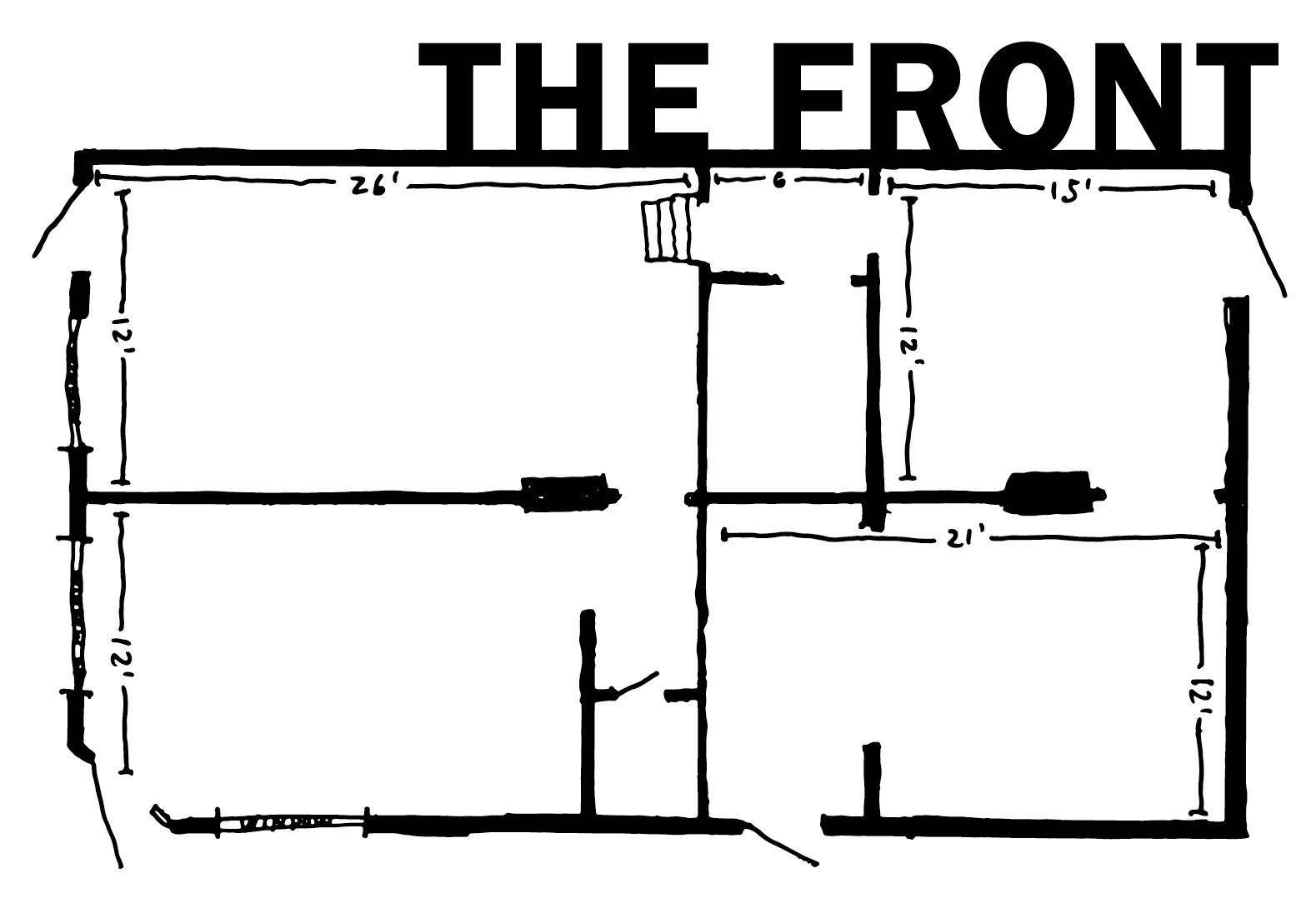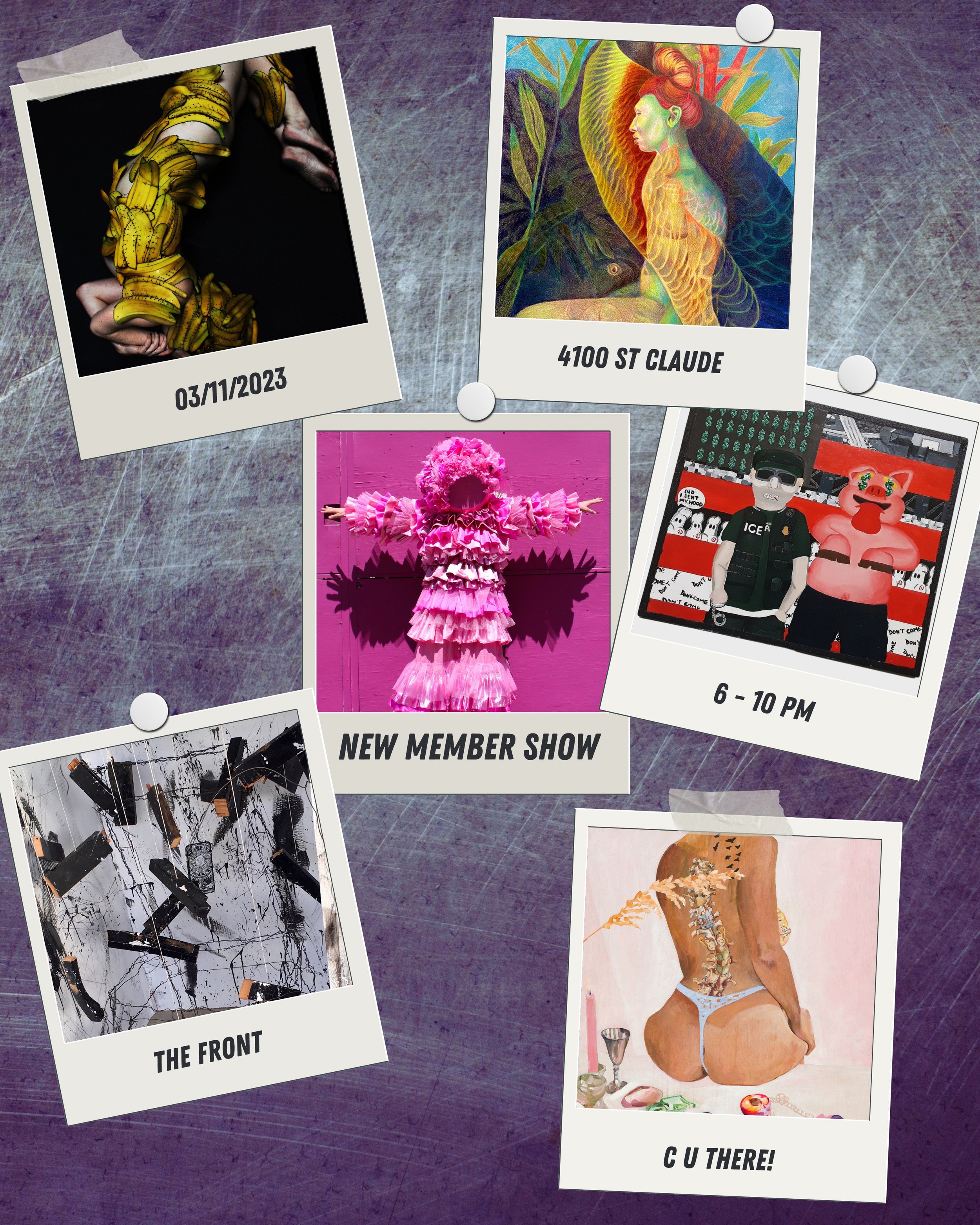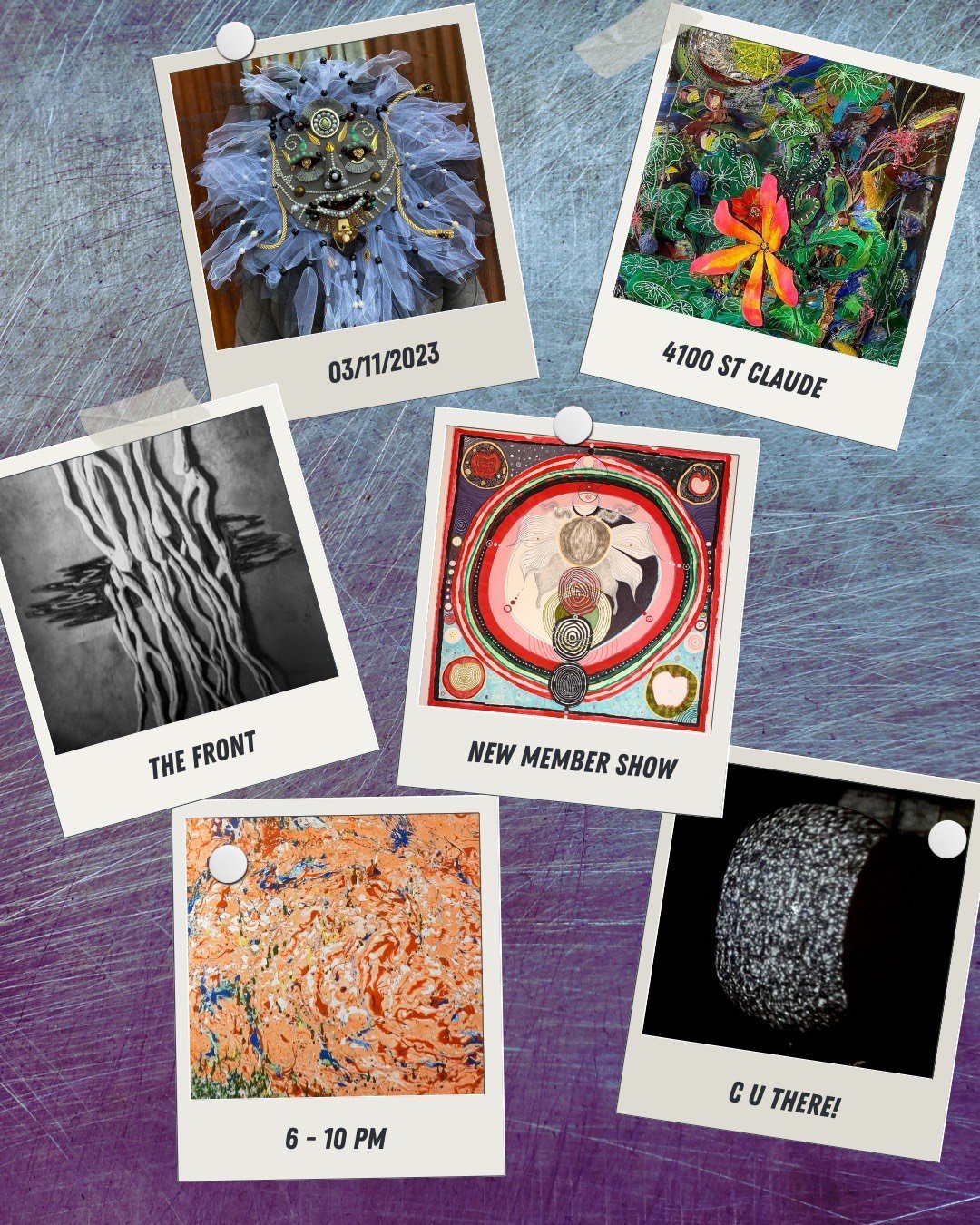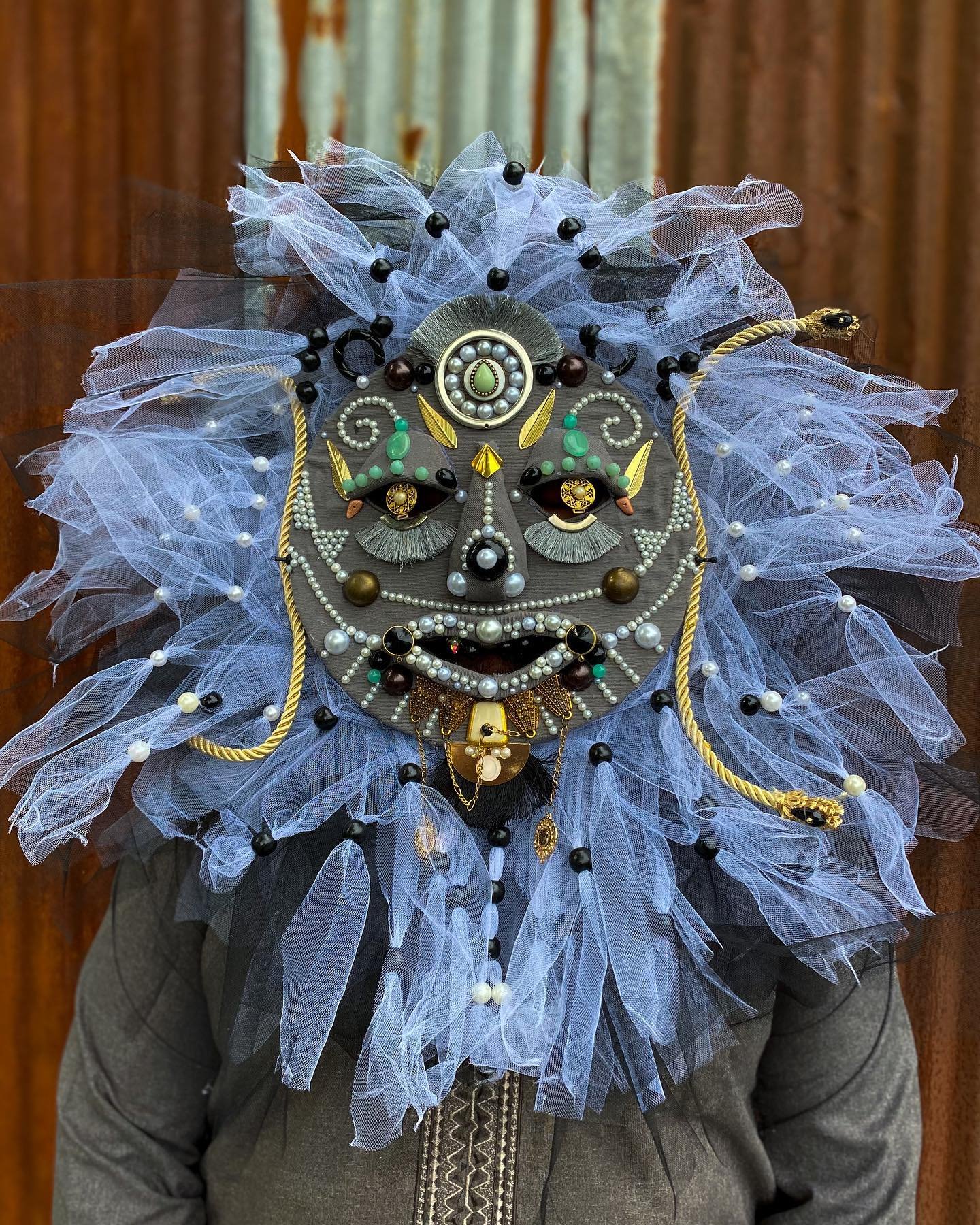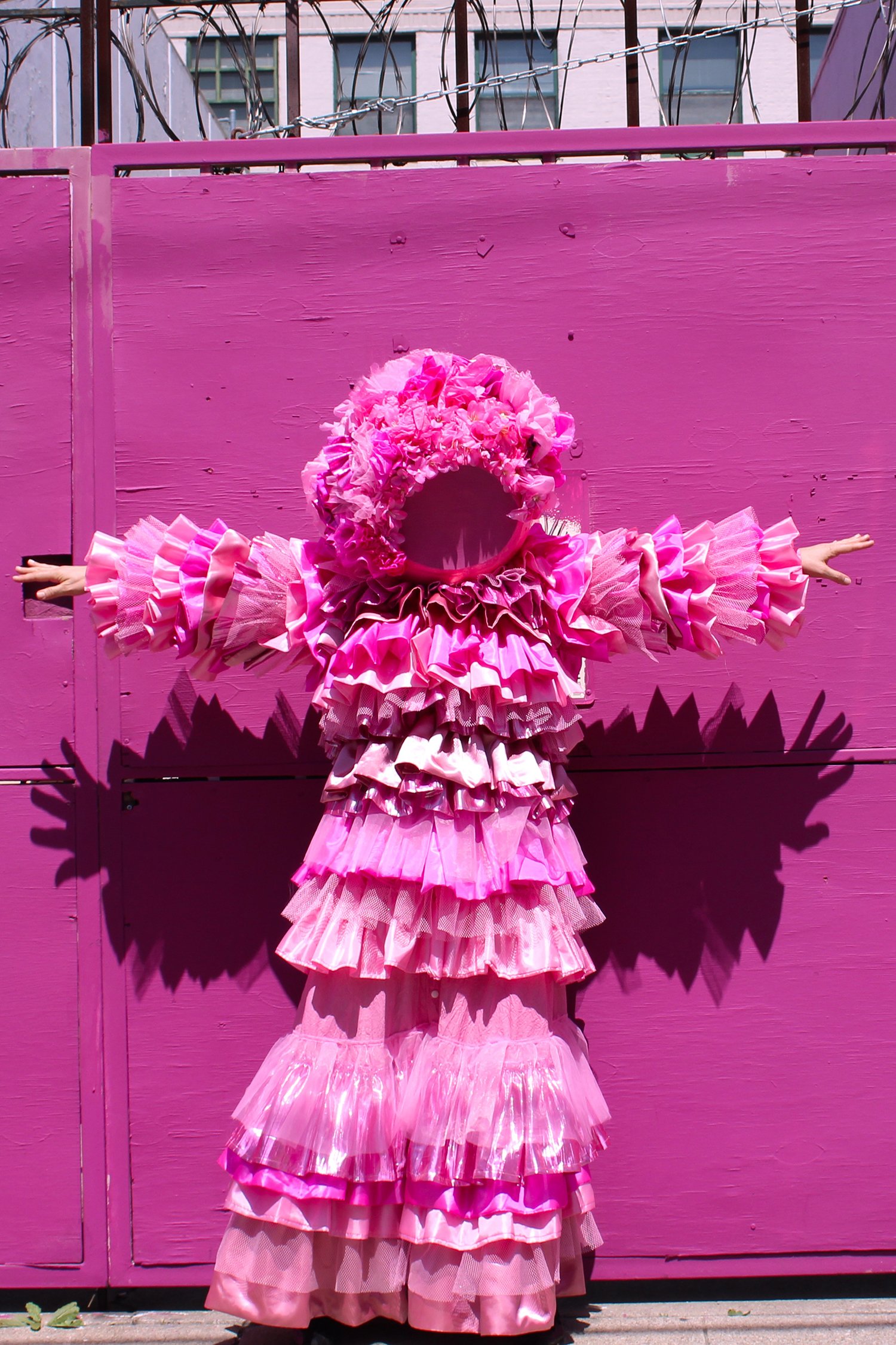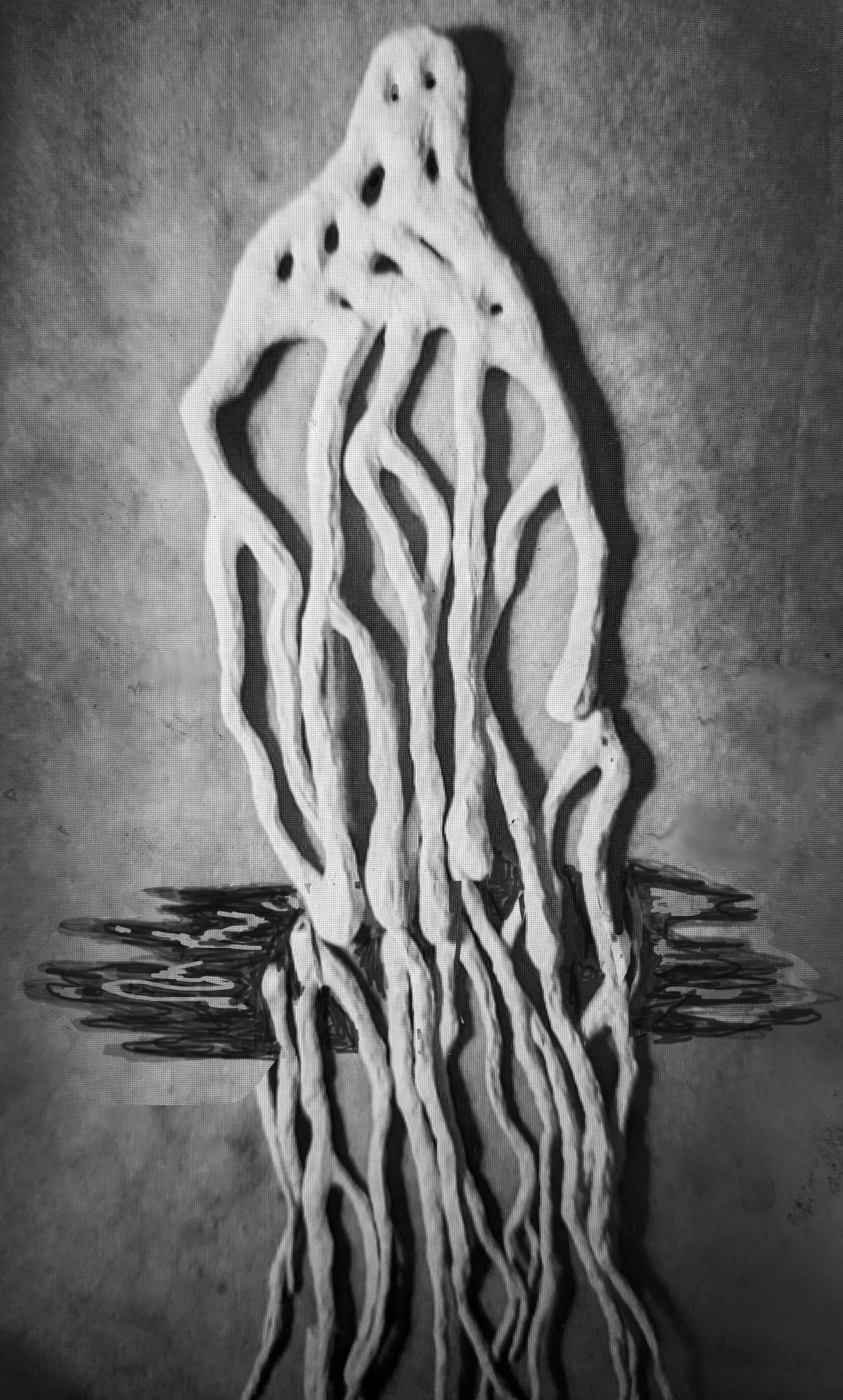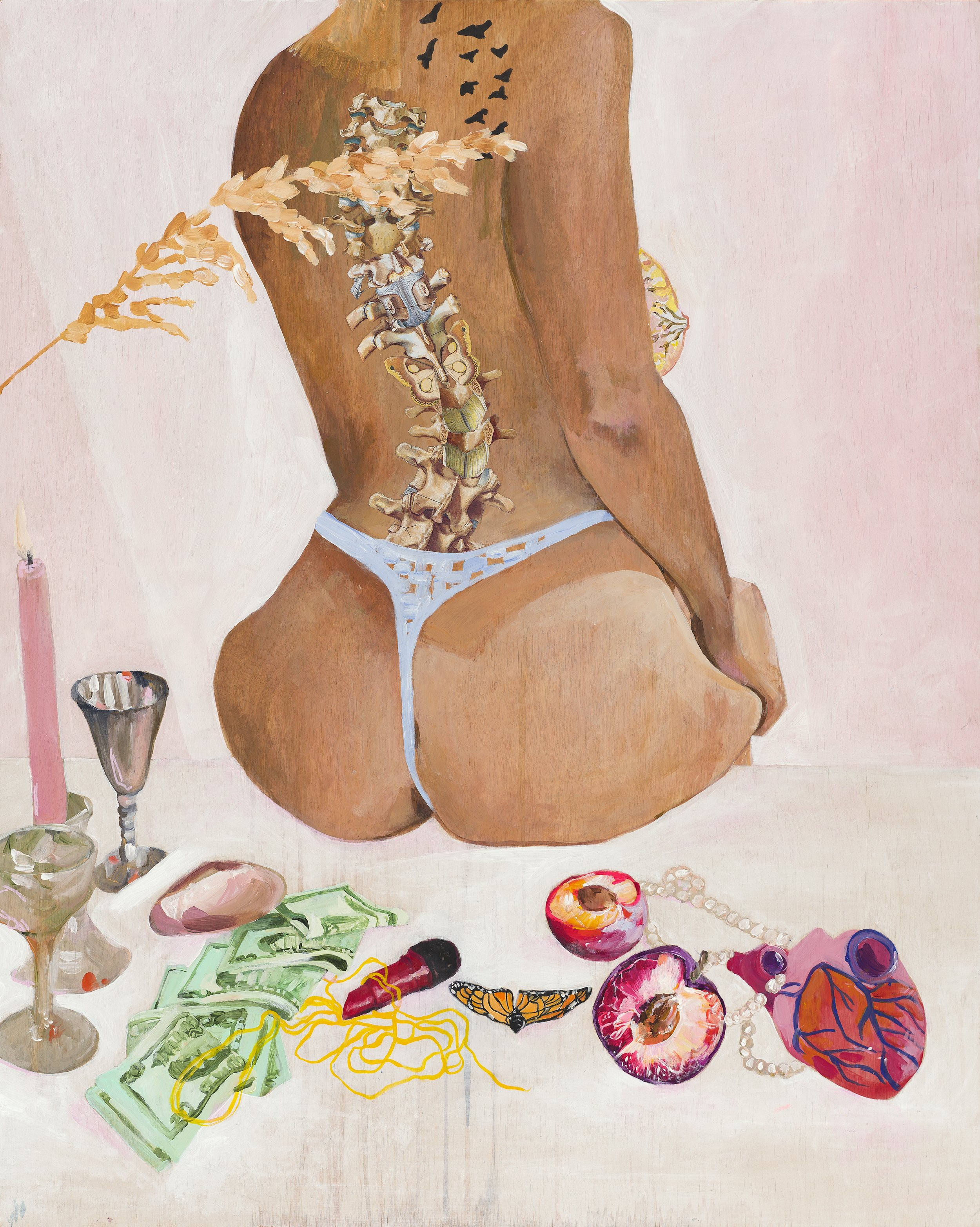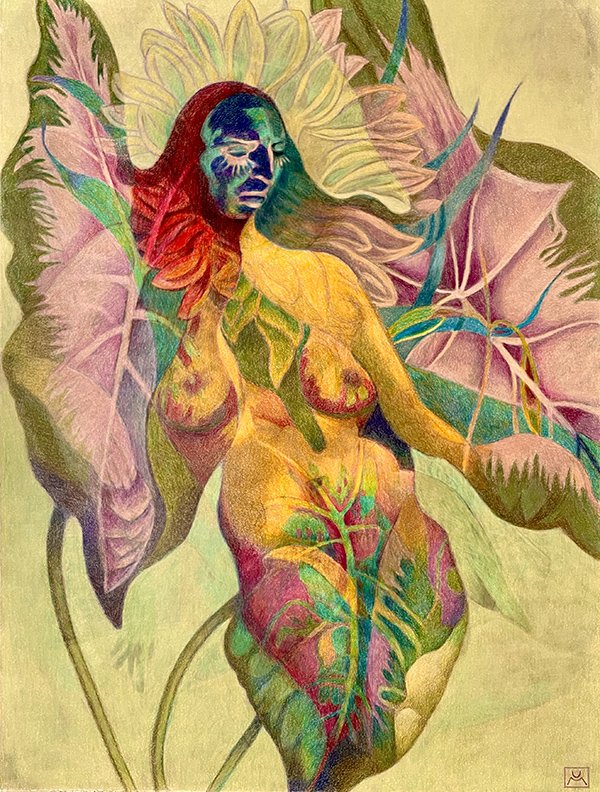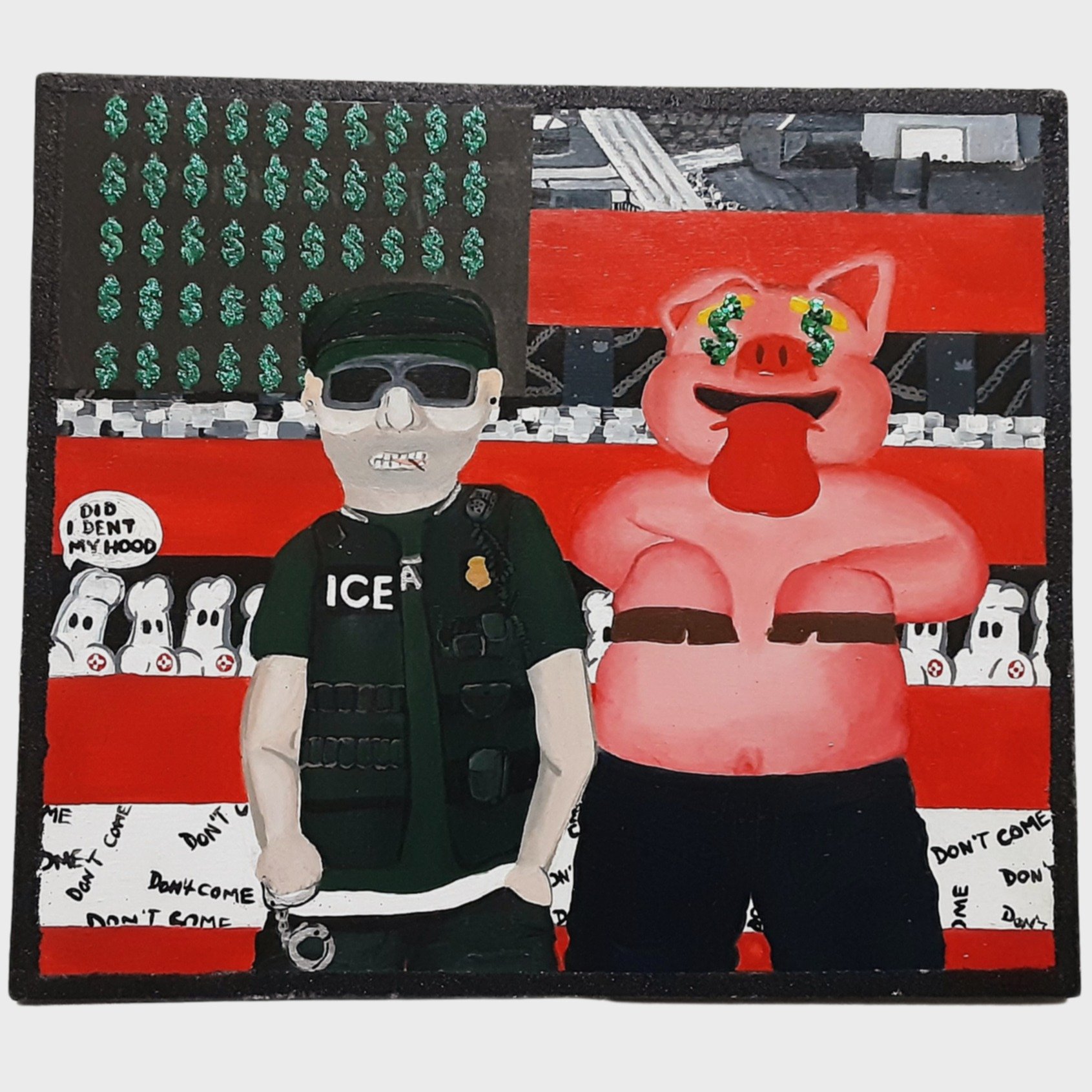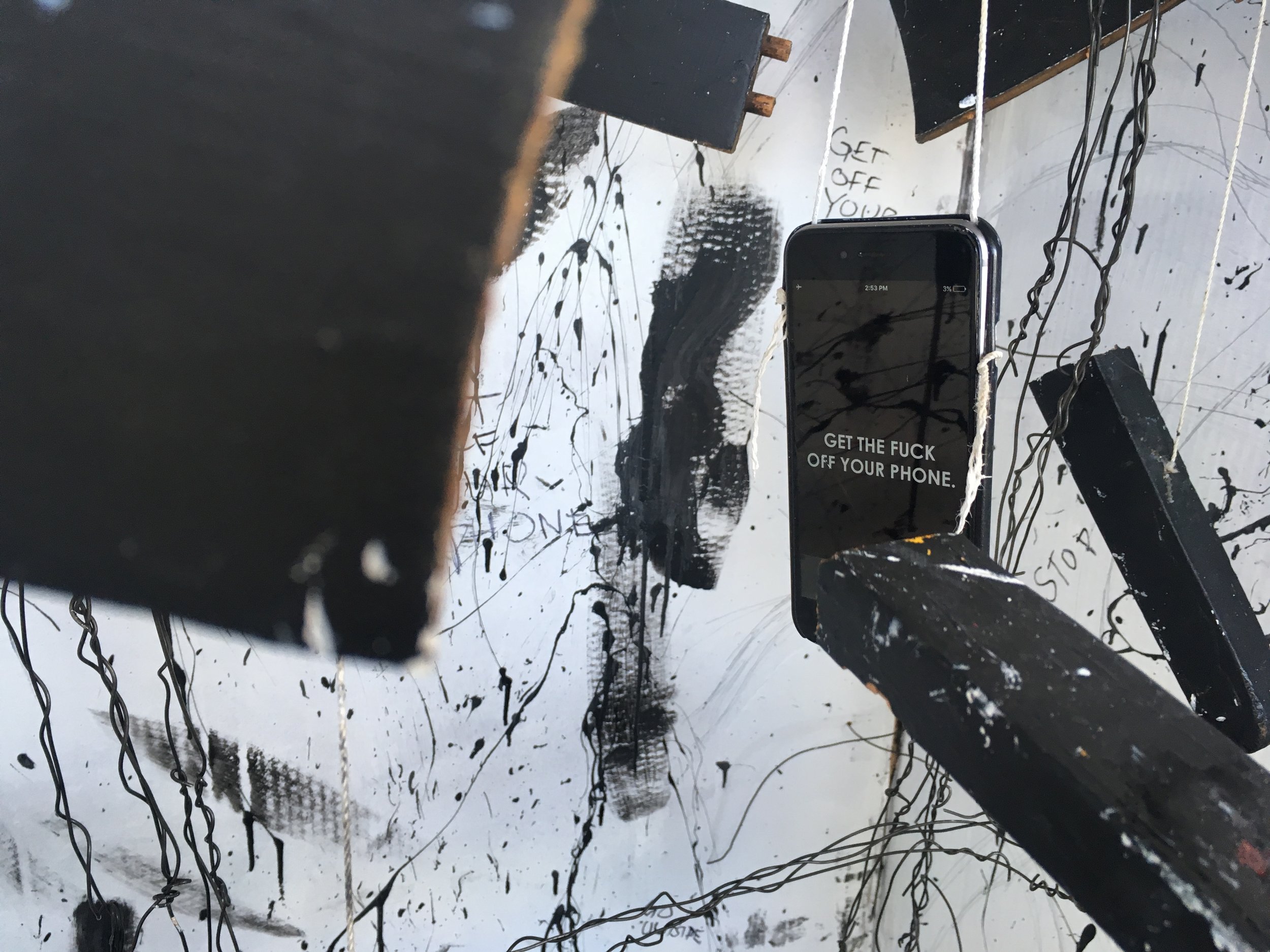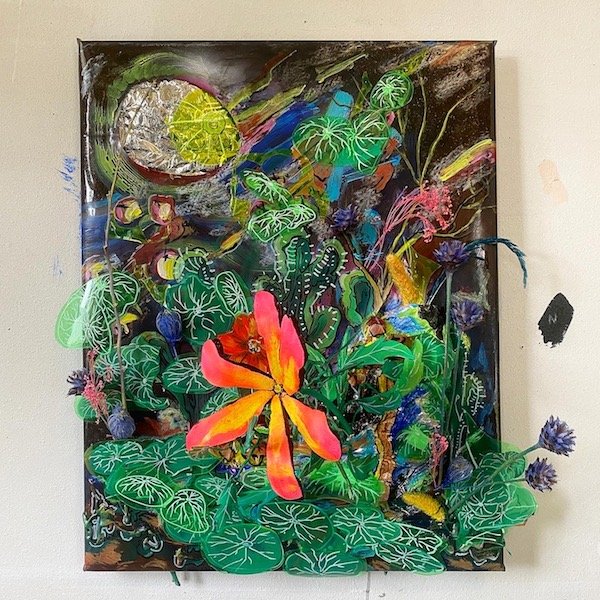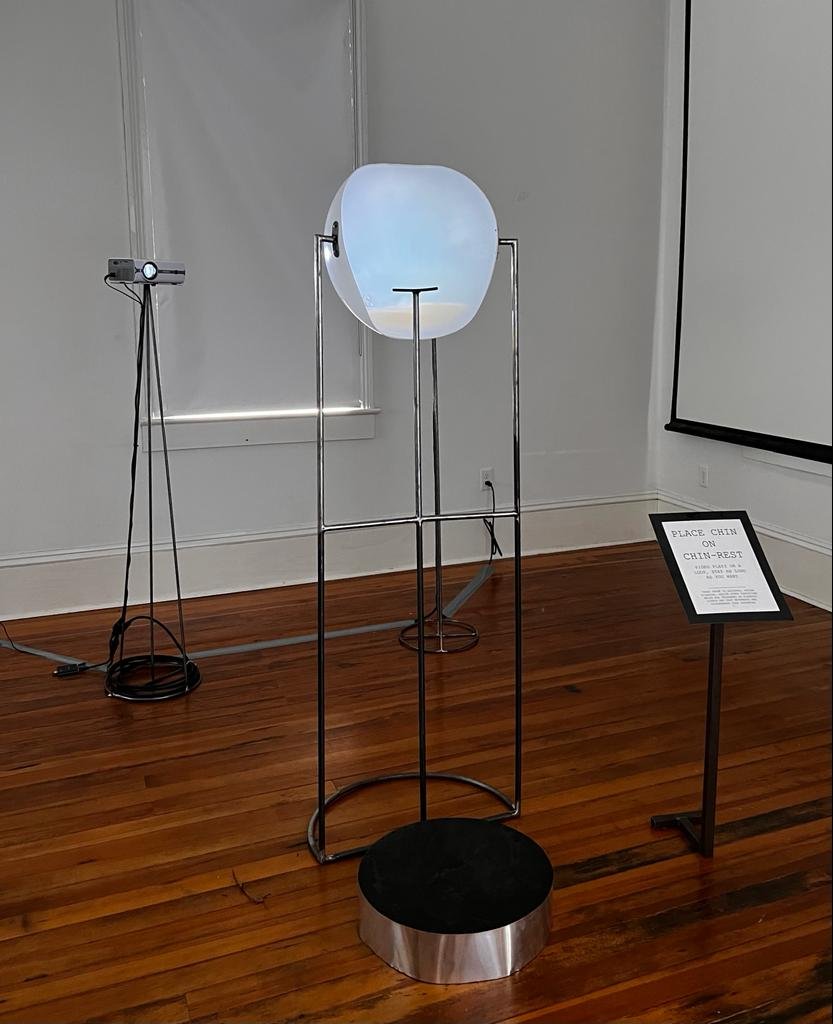March 11 - April 2, 2023
Opening reception on Second Saturday, March 11, 6-10pm.
Gallery open hours are Saturdays and Sundays, 12-5pm.
Be sure to check out The St. Claude Art Rag for more info on the Second Saturday Art Openings on St. Claude!
Room 1
Basqo Bim, El Chaparron Dorado, Mixed Media, 24 x 24 inches, 05/2022 : Juanburguesa Pablo Miele Chimichurri de Cimarrón Aguacate de las Santísimas Vegas hasta los Cielos Divinos o Lo Que Sea.
Christine Crook, Pink Baba, Gather Stitched salvaged pink fabrics and paper mâché head, 2020.
Kelsey Scult, Peeled, Banana Peels, Velvet, Thread, 22 x 18 inches, Digital Print on Metal, 2018.
Basqo Bim is a Colombian-American multidisciplinary artist based in New Orleans with a focus on assemblage and sculpture. Their practice centers around the intentional antagonization of the tensions between their intertwining and conflicting needs, desires, paranoias, and nostalgias. Their intent is to explore their physical, mental, and psychological limitations in terms of the process of creation and manifestation of their work, and finding new ways to push past the existing boundaries into newer, unknown territories. Simultaneously, their practice revolves around fostering a meditative and healing form of art practice for themselves. Both of these opposing approaches work together to forge a space of internal dialectics in their practice and process, driven by a need to push every facet of their work to adverse extremes in each piece. Their desire is to offer new worlds to the viewer by reflecting their own tensions onto the viewer by utilizing a jarring shift from consensus reality, while also offering visual and psychological anchors rooted in familiar temporal and cultural reference points.
Christine Crook is a costume and performance artist based in New Orleans. Her wildly strange costumes and performance art are a recent divergence from a long established career in costume design for theatre, opera, and dance. Through this divergence she experiments with abstract costumes that re-imagine the structure of how design is utilized in performance, and offers a poetic interpretation of character through costume and other visual forms. Her recent studio work is inspired by traditions in drag, folk art, the occult, and global masquerade. These influences are often blended through an eccentric campy lens that celebrates women, and challenges stereotypes of gender, and sexuality. Christine’s work aims to allow the costume to exist on its own as a magical sculpture distorting and transforming the body of the wearer. Christine has presented design-driven live art and costume installations with Metalhaus Gallery, Failed Films Festival, Dream Farm Commons, FILF Fashion, Z Space, and Shotgun Players. She was awarded a Bridging The Gap Grant for continued experimentation with costume design funding a gallery residency in Berlin 2017. She also participated as an artist in residence with Light Box in Detroit 2019. Christine has an MFA in Costume Design from UC San Diego, and teaches costume design with the Academy of Art University.
Kelsey Scult is a New Orleans-based filmmaker and multidisciplinary artist. Her work explores the processing of inherited memory, the psychic untangling of intimate partner violence and the physical intersection of desire and decay. She produced the 2021 Sundance Audience Award-winning feature film “Ma Belle, My Beauty” which opened in over 40 theaters nationwide and was acquired for domestic and international distribution. She is an alumna of the New Orleans Film Society Southern Producers Lab. She was a featured artist in the 2021 and 2022 “Louisiana Contemporary” exhibitions at the Ogden Museum of Southern Art, and was one of the ‘21 juror-selected Best in Show artists. She was a founding member of the Lucky Art Fair artist collective which held the first contemporary art fair to be held in New Orleans. She is the Co-Manager of Creative Services at New Orleans Video Access Center (NOVAC). Her short film “SLICE” is currently on the festival circuit.
Room 2
E Marshall, The World, mixed media on paper, 15 x 15 inches, 2022.
Raina Benoit, Sea Bones, Paper Mâche, beeswax, 7.5 ft x 5ft, mixed media, 2020.
Summer White, Reap, Mixed Media on Wood Panel, 2 x 3 ft, 2022.
Ulrika Matthiessen, Amarum Dulcis, colored pencil on paper, 18 x 24 inches, 2022.
E Marshall lives and works in New Orleans, Louisiana. They spent their childhood in the Midwest and moved to New Orleans in 2012. They work across several mediums including drawing, painting, sewing and installations. Their work explores ideas of mental space-scapes and parallel universes using bold imagery and lots of color. Loves to scribble.
Louisiana & France-based artist, Raina Benoit's work investigates the human body's relationship with the environment. . Benoit received her BA from Louisiana State University in Liberal Arts. After living and working in New York City, she continued her studies in France at the Atelier des Beaux-Arts de la Ville de Paris where she studied painting and drawing. She completed her MFA at the University of Arizona and for close to a decade lived and researched along the U.S. Southeast’s coastline. She lived in the southwest of France, studying the healing arts and living as close to the land as possible in a creative space entitled, “The Creative Refuge”. She has recently relocated with her family to New Orleans, Louisiana a place she considers home.
Summer White is a New Orleans based artist. Her work explores the relationships between memory, instinct, sexuality, plants, myth, and anatomy. Her creations are a place in which objects, people, patterns, flora and fruit become cultivated landscapes of metaphor that strive to reclaim and amplify sensual agency in the body. Though painting is her main medium, she also does photography and set design. Recently, Summer completed a 5 month residency at The Joan Mitchell Center. She procured a BA in Visual Art and Psychology from The Evergreen State College in 2015. In 2019 she participated in The Lucky Art Fair. She has worked as a set designer for a Huemid Haus production of “Getcha Sum'' and “Slice”, a film by Kelsey Scult. She was born and raised in Texas.
Ulrika Matthiessen is a visual artist born in Sweden, raised in the American Deep South, and currently living and working in New Orleans, Louisiana. Her paintings, drawings, and mixed media works often center around the human figure, with all its implications, where multiple layers of imagery overlap and merge to weave a complex mixture of representation and abstraction. She discovers themes and meaning emerging throughout her working process, preferring the evocative over the literal. Matthiessen holds a MArch, a BArch, and a BFA in painting from Tulane University. She has artwork in the collections of Xavier University and the Whitney Plantation Museum.
Room 3
Déja Jones, Greedy Piggy x Stankonia Paper, Acrylic Paint, and Glitter on Wood 7.5 x 8.5 x .25 inches, 2021.
Sly Watts, A SEAT IN THE MIND, Wood, Tie Wire, Cardboard, and Cellphone, 3 x 3 x 4 feet, 2018.
Hayley Samantha Jensen, Elephant Ears on Trash, Acrylic on reused plastics, 48 x 24.5 inches, 2023.
In 1971 American President Richard Nixon declared war on drugs. According to a candid and controversial interview with former White House Adviser, John Ehrlichman, the war was a political tool to target and criminalize Black people. “We know we couldn’t make it illegal to be either against the war or be Black but by getting the public to associate the hippies with Marijuana and the Black people with Heroin, and then criminalizing both heavily, we could disrupt those communities. We could arrest their leaders, raid their homes, break up their meetings, and vilify them night after night on the evening news.” Political schemes like Nixon’s harmful agenda to modern adaptations like Trump’s Wall create stereotypical and false narratives of Black and Brown communities that have devastating and long-lasting effects. From childhood, Black and Brown communities are criminalized for their existence and pushed into socio-political systems that work in tandem, allowing them to be exploited for capitalistic gain. Baller Block’n, visually inspired by the 2000 film and gangster rap album set in New Orleans' Magnolia Projects, tells a story from my perspective centering on the grace, strength, and beauty of Black Indigenous People of Color as they continue to live within suffocating socio-political systems and violent and abusive governance- an unfortunately common theme across the globe represented by dictators at large Vladimir Putin, Nicolás Maduro, Daniel Ortega, and Kim Jong-un. -Déja Jones
Sly Watts, born and raised in New Orleans, LA, taught himself several creative skills, including illustration, painting, rapping, music production, and animation. Sly later formally learned graphic design, which evolved into a freelance design practice. Sly then created artworks based on music he would write, record and produce in Ableton Live. He continues to develop his visual work with large-scale illustrations and paintings. These works explore the expression of characters in abstracted settings, and how those characters reflect our thoughts and behaviors. His music experiments with hip hop, pulling from jazz, funk, electronica, rock and pop, among other genres. Sly continues to construct work through different mediums, in order to map various forms of emotion and movement.
Hayley Samantha Jensen is a New Orleans based visual artist and teacher. Originally from the New Orleans area, Jensen received her BFA in Studio Art from LSU and later went on to receive her MFA in Studio Art from San Francisco Art Institute. Since returning to New Orleans, she has worked as a painter and maker for animation film productions, event fabrication, window displays, floral installations, and murals. Elephant Ears on Trash is a part of Jensen's new series titled Plastic Garden, where her connection to and dissociation from synthetic plastic trash and the natural world are examined and made manifest through cultivating a reclaimed plastic garden.
Room 4
Diane Appaix-Castro, In Cipher, Multimedia Experiential Installation, 2023.
anderson funk, Bloated, Oil on panel, 40 x 60 inches, 2016, a painting done with the assistance of water.
Diane Appaix-Castro is a French and Spanish multimedia experiential installation artist living in New Orleans, Louisiana. She was born in Paris, France, and grew up in Cambridge, Massachusetts. She holds an MFA in Studio Art from Tulane University and a BFA from the New England School of Art and Design at Suffolk University. Diane also directs an exhibition space, Studio Appaix, in a New Orleans basement. In 2020 she was awarded first place in DIY Art for the show titled Reconnecting in Quarantine at Tulane Hillel. In 2021 Diane received the SLA Graduate Student Summer Research and Write-Up Fellowship Grant and participated in the Southern Heat Exchange Online Residency. Her work is strongly informed by her experience living at the intersection of three distinct cultures as well as her interests in science, philosophy, and religion as systems humans use to answer questions about our place in the world. Diane aims to push the boundaries of human understanding of what is real and alive by putting into question the credibility and accuracy of our senses. She hopes to push the viewer, or partaker, to see the world as larger than their own experience of it and to become aware of the unknown.
Anderson Funk lives in New Orleans Louisiana, where he hosts a radio show on WTUL, organizes impromptu theater, sings in a choir and sleeps. He attended graduate school at Maryland Institute College of Art in Baltimore and Vanderbilt University in Nashville. “My practice follows after influences such as June Jordan and Allan Kaprow. It blurs into my life. I strive to expand realms of possibility by making silly and inscrutable objects, writing through my understanding, and study of/with my surroundings. I like to work on revealing frameworks, patterns of the “usual”, for two main reasons: a) transcending frameworks is a liberatory practice, in the act of investigating limits I have the chance to see from a broader perspective. b) frameworks function well to facilitate life and when they become visible it is easy to see how much we share and create with every other person, even our “enemy”"
